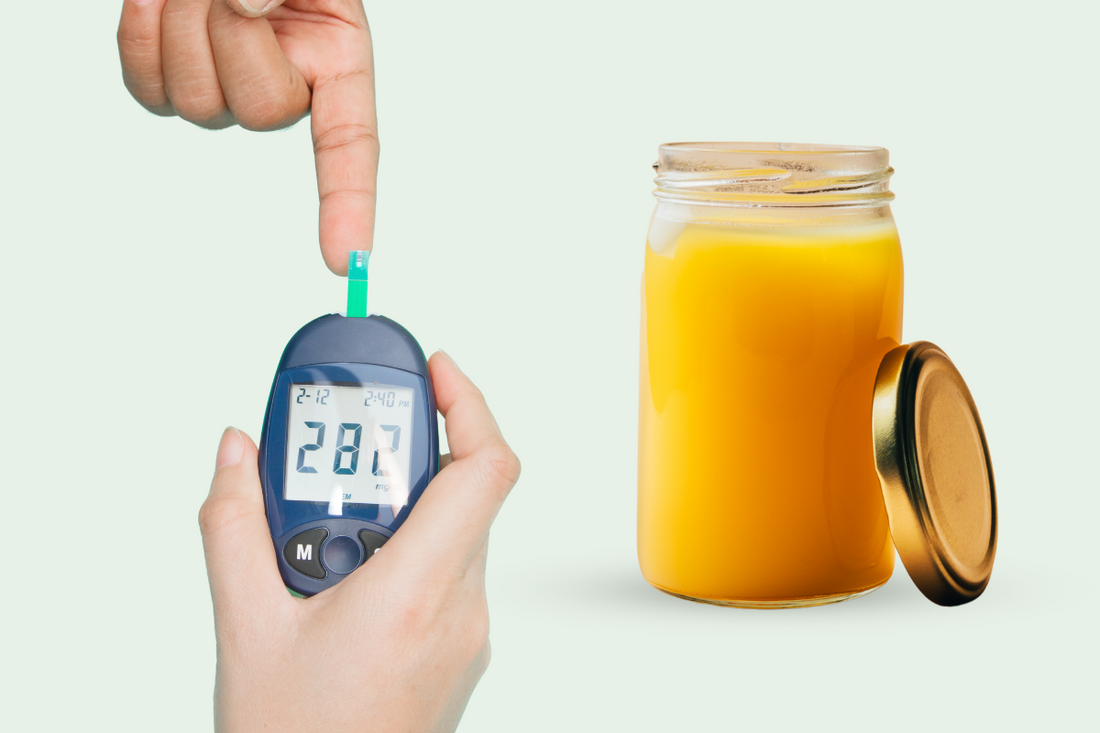Ghee (clarified butter) is a traditional fat rich in fat-soluble vitamins and short-chain fatty acids, offering various benefits:
- Stabilizes Blood Sugar Levels

Ghee has a low glycemic impact and can slow down the absorption of sugars when paired with carbohydrates, reducing blood sugar spikes.
Adding ghee to rice or bread, common in Indian diets, can help regulate post-meal glucose levels.
2. Improves Insulin Function
Ghee contains butyric acid, which may improve insulin sensitivity and support better glucose regulation.
3. Promotes Gut Health

The butyrate in ghee helps nourish the gut lining and promotes healthy digestion. A healthy gut is crucial for managing inflammation and improving metabolic health in diabetics.
4. Rich in Vitamins
Ghee is an excellent source of fat-soluble vitamins A, D, E, and K, which support immunity, vision, and bone health—areas often affected in diabetes.
These vitamins also support hormonal balance, which can indirectly aid diabetes management.
5. Anti-inflammatory Properties
Ghee has anti-inflammatory benefits that can help reduce chronic inflammation, a key factor in insulin resistance and complications related to diabetes.
6. Good for Weight Management

Ghee enhances satiety and can help control appetite, assisting in weight management—a critical factor for diabetes care.
How to Use Ghee for Diabetes
1. With Whole Grains:
Add a teaspoon of ghee to cooked whole grains like brown rice, quinoa, or millet. This combination lowers the glycemic index of the meal, providing sustained energy without blood sugar spikes.
2. Cooking Vegetables:
Sauté vegetables in ghee instead of refined oils. Ghee enhances the absorption of fat-soluble vitamins in vegetables, contributing to better nutrition.
3. In Rotis or Parathas:
Spread a thin layer of ghee on whole-grain or multigrain rotis. This traditional method can make meals more satisfying while helping regulate post-meal glucose levels.
4. In Dal or Soups:
Add a teaspoon of ghee to your lentils, dals, or soups for enhanced flavor and improved satiety.
5. With Herbal Teas or Milk:
Mix ghee with warm turmeric milk or herbal teas. Turmeric, combined with ghee, can help reduce inflammation, a common concern for diabetics.
6. For Fasting:
During intermittent fasting or Ayurvedic fasting, consuming ghee in small amounts can provide energy without disrupting blood sugar levels.
Tips for Using Ghee Safely
1. Moderation is Key:
Limit ghee to 1-2 teaspoons per day to avoid excessive calorie intake.
2. Choose Quality Ghee:
Opt for good quality pure ghee, free from additives. This ensures maximum nutritional benefits.
3. Avoid with Heavy Meals:
Skip ghee in meals high in saturated fats or fried foods to prevent overloading on fats.
4. Consult Your Doctor:
If you’re on a specific diabetic diet, talk to your healthcare provider or nutritionist before incorporating ghee.
Conclusion
Ghee, when used in moderation, can be a healthy fat choice for individuals with diabetes. Its ability to improve digestion, regulate blood sugar levels, and enhance nutrient absorption makes it a versatile addition to a diabetic-friendly diet. Pair it with wholesome, low-glycemic foods for a balanced approach to managing diabetes while enjoying delicious, flavorful meals.


